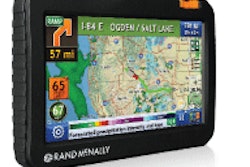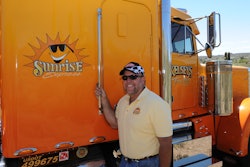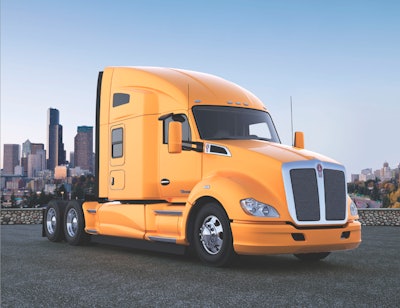
The Kenworth T680, though similar to its T660 and T700 brothers, forges new ground with a spacious, driver-focused interior.
 The T680’s design was based on extensive driver interviews and interactions in an adjustable cabin space. This helped engineers to optimize comfort, usability and visibility.
The T680’s design was based on extensive driver interviews and interactions in an adjustable cabin space. This helped engineers to optimize comfort, usability and visibility.The number says it all. Kenworth’s new and best-kept secret T680 falls midway between the T660 and the T700, launched a year ago. The 660 has the traditional Kenworth cab at 75 inches, the T700 has the 90-inch cab. The T680 falls in the middle at 83 inches, appealing to buyers for whom the narrow T660 cab is just too tight at the shoulders for easy access to the back into the sleeper.
Sister-brand Peterbilt shares the basic cab construction in its corresponding 579, which was also launched this spring. Both are highly tooled stamped aluminum structures with complex panels joined by Henrob fasteners to create a rigid aluminum cab structure. The rivets are blind and no heads stand out on the smooth cab surface except at the rear corners.
In the same way as the T700 picked up strong styling cues from the T660, the new T680 is clearly recognizable as being from the same family. It’s designed to have wide appeal with its extra accommodation over the T660 without the vastness of the T700 and a comprehensive rethink of an all-new interior.
In the concept phase, more than 850 drivers were interviewed and asked to sit in an adjustable cabin space. The goal was to optimize it for a wide range of driver types and sizes, says Jim Bechtold, Kenworth director of product planning. The resulting 680 is available as a daycab or as a fully integrated sleeper.

Engineering
 It is essential to specify the swivel passenger seat to gain maximum advantage of the flexibility designed for the T680’s seat and table.
It is essential to specify the swivel passenger seat to gain maximum advantage of the flexibility designed for the T680’s seat and table.The T680 cab features highly tooled door opening pressings and triple-sealed doors that guarantee excellent fit. With a pressure relief valve included, closing the door requires only the slightest effort. Styling lines in the panels guarantee integrity of the cab and structural stiffness; a deep side window and excellent new mirrors provide great visibility.
While it may appear a little funky when looking at the windshield top corner and the side window line, the extra tall windshield brings light into the cab and enables a view of overhead traffic lights.
The aerodynamic design was achieved with Magna International, claimed to be the biggest supplier of automotive components. The T680’s aerodynamic shape benefits from a sculpted full-height roof, an optimized bumper and hood, full-height side extenders, cab/sleeper-to-fairings closeout panels, chassis fairings extenders and flush-mounted lighting. Kenworth says it adds up to a 10 percent enhancement in aerodynamics over existing models, including the T660.
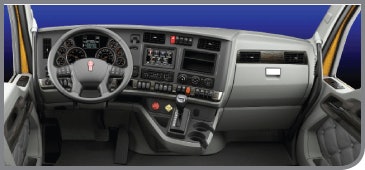 In the new instrument cluster, designed for maximum legibility, switches’ proximity to the driver is according to function. Controls for the fifth-wheel slider, air dump valve and so on are farthest away because they are used infrequently.
In the new instrument cluster, designed for maximum legibility, switches’ proximity to the driver is according to function. Controls for the fifth-wheel slider, air dump valve and so on are farthest away because they are used infrequently.The T680 was engineered with 65 percent more storage capacity than the T660 with a 50 percent larger windshield and 40 percent less interior noise. Door openings are 30 percent larger.
The hood is wider and lower than the T660’s. Headlights are dual halogen (standard) with optional HID Xenon lamps, which Kenworth says creates the industry’s best forward lighting. The hood is in three parts for easy, less costly repair. The bumper is split for similar reasons.
Along with good side and rear visibility, the forward view is enhanced with a steeply sloping hood and carefully angled “A” pillars for minimum intrusion into the field of view. Mirrors are cowl-mounted.
CAB AND SLEEPER
Everything has been done inside to make use of the additional cab width. The driving position faces a new instrument cluster where gauges that previously had migrated across the dash are now grouped within the arc of the steering wheel.
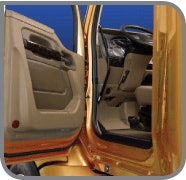 Instead of using flat aluminum panels, bulkhead-style doors and composite panels for the more complex shapes, the T680 has highly tooled doors and door openings and complex curves in the sheet metal and base cab structure.
Instead of using flat aluminum panels, bulkhead-style doors and composite panels for the more complex shapes, the T680 has highly tooled doors and door openings and complex curves in the sheet metal and base cab structure.“Based on our expandable cab data, we started with the ‘driver’s space,’ creating the ideal position for the pedal package, the optimal seating position and steering wheel location,” says Wally Peltola, Kenworth design director. “The air-assisted hydraulic clutch we designed requires only half the pressure of a traditional clutch, plus less travel, so it’s very easy to engage. It allows a woman in the 5th percentile of size, as well as a male in the 95th percentile, to maintain easy clutch control. That is a major leap forward in accommodating drivers.”
The Driver Performance Center is a high-resolution, 5-inch display that shows current truck information, diagnostic data and pop-up alerts. It will also display recommendations to help improve vehicle performance.
The proprietary seats are manufactured along with other interior modules by Magna. The seats’ air suspension system automatically adjusts to driver weights. An adjustable shock provides a full range of seat comfort for driver preferences. An optional passenger 180-degree swivel seat allows the occupant to face into the sleeper. Combined with the rotating table, this creates an industry-leading work and living environment.
In the totally redesigned sleeper, a unique passenger-side table can swivel back to the bunk. Its rugged work top has been designed to sustain a 450-pound load. Making the most of this table feature is a foot-operated swivel option for the passenger seat that brings the seat around to face the table. There it can be used as a pull-up chair for work, eating or other activities. For relaxing, the seat can be kicked back like a recliner.
The cabinet stack that supports the table has a microwave space over the table, and a flat-screen mount on a swivel that means the TV can be seen from the turned passenger seat or swung back for ideal viewing from the bunk.
On the other side of the truck is the refrigerator space that houses an optional slide-out, top-loading fridge and features a step for easy access to the optional upper bunk.
On The Road
My test drive in Kentucky went from Louisville to Elizabethtown and back. On the way out, I drove a daycab T680 with Paccar MX power; on the return, an impressive integrated cab/sleeper with Cummins ISX 15 with 485 hp.
The most memorable thing about the cab is its extremely rigid-feeling construction. There is no booming amplification of road or mechanical noise as sometimes occurs with the flat-panel riveted construction of the narrow cab.
Also immediately apparent is the terrific visibility through the low side glass, the panoramic windshield, the sloping nose that can hardly be seen from the driver’s seat, and the excellent cowl-mounted mirrors that are rigid and vibration free.
On the short-wheelbase daycab, the transitions on bridge approach and departure were definitely felt, but the absence of any exterior or cab noise as these events happened was also noticeable. This new truck is extraordinarily quiet, partly because of the low-noise 12-liter Paccar MX in the daycab model.
The 10-speed manual shifted with the usual Kenworth precision and the truck steered well, staying on line and cutting into curves with the first movement of the steering wheel.
The navigation panel is the Kenworth NavPlus execution of the PACCAR driver infotainment system. It is multi-functional and includes the addition of virtual round gauges to supplement the nine gauges in the main dash. In all, there are 12 additional gauges available in the NavPlus.
The driving return loop was in the sleeper truck. With its Cummins ISX 15 and 13-speed UltraShift transmission, it was easy, quiet and a joy to drive. Part of this was due to the Kenworth air-ride AG130 front suspension. Ambient red mood lighting adds to the presence of the interior and the new, wider seats offer additional driver comfort.
Kenworth likes the bottom-hinged accelerator pedal, which always makes it a little difficult to place the right foot when using cruise control. Also, the brake pedal sits very close beside the accelerator. But these are small quibbles.
Among the sleeper appointments, one great feature is the door-lock switch on the sleeper control panel – a nice touch that shows the engineers really listened to the drivers. I mean, how often have you tumbled out of the bunk just to check door locks?
The new, wider T680 may cannibalize a few sales from its T660 and T700 brothers, but more likely it will acquire new sales from competitive brands. It is an exceptional new introduction that will be highly popular with drivers and should do well for Kenworth.
Powertrain
The T680 is available with the Paccar MX engine as the standard position, but then there’s the Cummins ISX in its established 15-liter configuration. Also released is the 11.9-liter ISX, which Cummins says shares much of the design philosophy of its bigger counterpart. It is, though, quite different in just about every respect.
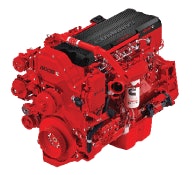 Cummins ISX 15
Cummins ISX 15The 11.9 has seen significant development as a natural gas engine and provides an interesting alternative fuel power unit for the new truck.
The Cummins ISX at a 485 hp rating is a 1,650 lb.-ft. engine, so it offers good performance and excellent fuel economy. Coupled with the 13-speed Ultrashift, it is a very flexible package that should please operators.
The transmission is an overdrive automated with a top gear ratio of 0.73. With the 22.5-inch Michelin rubber turning 511 revs per mile, the overall gearing gives the truck a tall 1,275 rpm at 60 mph, or 1,380 at 65 mph.
Backing it down to 62 to gain the best fuel economy sees the engine turning at 1,320 rpm, way down the speed range but still with the ability to pull small grades without downshifts. And with the automated transmission in control, the driver doesn’t need to be concerned about that in any case.
Kenworth T680 test vehicle specs
Frame: Kenworth steel, 10-5⁄8 by 5⁄16 inches
Engine: Cummins ISX 15, 485 hp, 1,650 lb.-ft. torque
Engine brake: Jacobs/Intebrake
Transmission: Eaton Fuller FO16E313A-MHP
Ultrashift Plus, 13-speed overdrive
Wheelbase: 229 inches
BBC: 125 inches
Front axle: Dana Spicer E-13221 3.5-inch drop, 13,200 pounds
Suspension: Kenworth AG130 air
Front brakes: Bendix RSD air discs
Rear axle: Dana Spicer DSP 41, 40,000 pounds
Suspension: Kenworth AG400L, 40,000-pound air-ride
Ratio: 3.42 to 1
Rear brakes: Bendix RSD air discs
Wheels: Kenworth 7-spoke hub pilot, outside polished
Fuel tanks: Dual 120-gallon, unpolished
Fifth wheel: Holland FWAAL-17
Seats: Kenworth GT704 HiBack leather passenger on swivel







